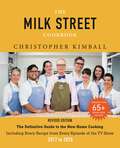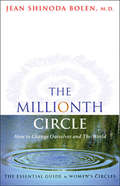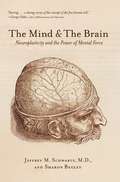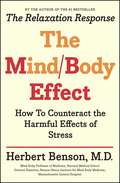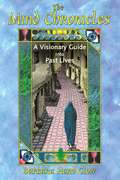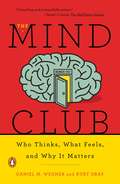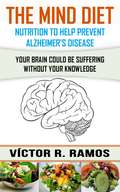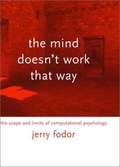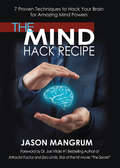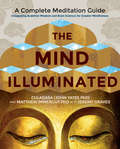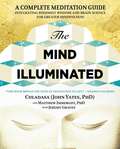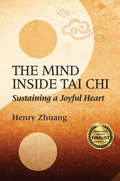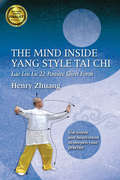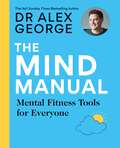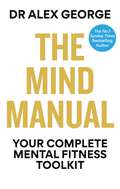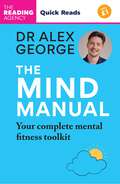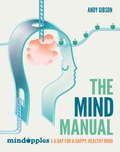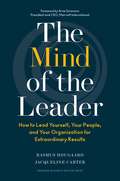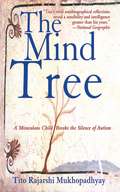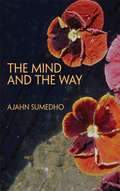- Table View
- List View
The Milk Street Cookbook: The Definitive Guide to the New Home Cooking, Including Every Recipe from Every Episode of the TV Show, 2017-2020
by Christopher KimballChange the way you cook with the definitive cookbook from James Beard Award-winner Christopher Kimball's hit Milk Street TV show--now updated to include every recipe from the 2019-2020 season. Christopher Kimball's James Beard and Emmy Award-winning Milk Street TV show and cookbooks give home cooks a simpler, bolder, healthier way to eat and cook.Now featuring more than 300 tried-and-true recipes, including every recipe from every episode of the TV show, this book is the ultimate guide to high-quality, low effort cooking and the perfect kitchen companion for cooks of all skill levels.At Milk Street, there are no long lists of hard-to-find ingredients, strange cookware, or all day methods. Instead, every recipe has been adapted and tested for home cooks like you. You'll find simple recipes that deliver big flavors and textures fast, such as:Stir-Fried Chicken with Snap Peas and BasilCacio e PepeNo-Sear Lamb or Beef and Chickpea Stew Somali Chicken SoupRoasted Cauliflower with Miso GlazeFrench Apple CakeAnd Central Mexican Guacamole and Israeli Hummus--classics with a twist!Organized by type of dish--from salads, soups, grains, and vegetable sides to simple dinners and extraordinary desserts--this book is an indispensable reference that will introduce you to extraordinary new flavors and ingenious techniques. Welcome to the new home cooking. Welcome to Milk Street.
The Millionth Circle: How to Change Ourselves and The World: The Essential Guide to Women's Circles
by Jean Shinoda BolenA guide to using female connection and empowerment as a force for change. “Short and poetic . . . a fine resource for building community.” —Spirituality & PracticeThe minds and spirits of women are powerful forces, particularly when harnessed in communion with other women. Women’s circles have been around for quite some time, and their presence is a healing and strengthening source for many. Furthermore, author and psychiatrist Jean Shinoda Bolen believes that women’s circles act as catalysts for change around the world. In this inspiring and spiritual book for women, Dr. Bolen provides both a guide and vision for women seeking purpose and change.Through her poetic language, Dr. Bolen emphasizes to her readers the importance of using their intuition and drawing upon their own insights. In bringing feminine values such as relationship, nurturing, and equality together, Dr. Bolen shares how women create a space for compassionate and radical growth.By focusing on both the psychological and spiritual, women open the doorway for great change and empower one another to be leaders of positive change in their own lives and beyond. In this way, women empowerment itself acts as a tool for societal and psychospiritual change. After all, when strong women join together, who can stop them?Read The Millionth Circle: How to Change Ourselves and the World and find . . . A tool for creating positive change Words of insightful and powerful feminine wisdom A book for women everywhere
The Mind And The Brain: Neuroplasticity And The Power Of Mental Force
by Sharon Begley Jeffrey M. SchwartzA groundbreaking work of science that confirms, for the first time, the independent existence of the mind-and demonstrates the possibilities for human control over the workings of the brain. Conventional science has long held the position that 'the mind' is merely an illusion, a side effect of electrochemical activity in the physical brain. Now in paperback, Dr Jeffrey Schwartz and Sharon Begley's groundbreaking work, The Mind and the Brain, argues exactly the opposite: that the mind has a life of its own. Dr Schwartz, a leading researcher in brain dysfunctions, and Wall Street Journal science columnist Sharon Begley demonstrate that the human mind is an independent entity that can shape and control the functioning of the physical brain. Their work has its basis in our emerging understanding of adult neuroplasticity-the brain's ability to be rewired not just in childhood, but throughout life, a trait only recently established by neuroscientists. Through decades of work treating patients with obsessive-compulsive disorder (OCD), Schwartz made an extraordinary finding: while following the therapy he developed, his patients were effecting significant and lasting changes in their own neural pathways. It was a scientific first: by actively focusing their attention away from negative behaviors and toward more positive ones, Schwartz's patients were using their minds to reshape their brains-and discovering a thrilling new dimension to the concept of neuroplasticity. The Mind and the Brain follows Schwartz as he investigates this newly discovered power, which he calls self-directed neuroplasticity or, more simply, mental force. It describes his work with noted physicist Henry Stapp and connects the concept of 'mental force' with the ancient practice of mindfulness in Buddhist tradition. And it points to potential new applications that could transform the treatment of almost every variety of neurological dysfunction, from dyslexia to stroke-and could lead to new strategies to help us harness our mental powers. Yet as wondrous as these implications are, perhaps even more important is the philosophical dimension of Schwartz's work. For the existence of mental force offers convincing scientific evidence of human free will, and thus of man's inherent capacity for moral choice.
The Mind Body Effect
by Herbert BensonFrom the author of #1 bestseller The Relaxation Response comes a practical guide to how behavioral medicine can counteract the harmful effects of stress and help you regain control of your health.“In The Mind/Body Effect, Herbert Benson, MD, redefines medical care as a process in which the mind and body are tended as components of a single vital organism, and calls upon individual patients to share with physicians the responsibility for their own medical well-being. Writing with brilliant clarity, he exposes hypes and commercialism within a society obsessed with health and terrified of pain. The Mind/Body Effect may be the most important medical book for laymen since Dr. Benson’s The Relaxation Response.”—Noah Gordon, publisher, Journal of Human Stress “In their avid pursuit of better health, millions of Americans are making themselves less healthy. Ironically, their doctors often make things worse instead of better. In this fascinating book, Dr. Benson tells us—patients and doctors alike —how to break the vicious cycle.”—David W. Ewing, executive editor, Harvard Business Review “The next great advance in the health of the American people will come not from hospitals or laboratories but from what they learn to do for themselves. The Mind/Body Effect represents a major step in that direction.”—C. Norman Shealy, MD, PhD, codirector, The Pain and Health Rehabilitation Center
The Mind Chronicles: A Visionary Guide into Past Lives
by Barbara Hand ClowA record of past lives experienced through hypnotic regression • Unlocks the primordial memory bank of planetary consciousness • Explores the past lives of spiritual teacher Barbara Hand Clow at sacred sites during historical periods critical to the development of human consciousness • With illustrations by Angela Werneke, illustrator of Medicine Cards • First editions collectively sold 60,000 copies Combined for the first time in one updated and revised volume, the three books of The Mind Chronicles Trilogy--Eye of the Centaur, Heart of the Christos, and Signet of Atlantis--show that all the places, times, and beings we have ever known exist now in our memory banks. Using the mind state produced during 100 sessions of hypnotic regression, Barbara Hand Clow unlocks the primordial memory bank--the records of time in which all humans participate--offering readers critical information to reflect upon now. In The Mind Chronicles, Clow guides readers through 100,000 years of human history, using in-depth experiences of initiations and sacred ceremonies to illuminate the forgotten wisdom of our ancestors. She shows that this ancient knowledge, which is contained deep within all of us, is becoming even more relevant as the Mayan Calendar comes to a close and a new stage of evolution begins.
The Mind Club: Who Thinks, What Feels, and Why It Matters
by Daniel M. Wegner Kurt Gray"Daniel Wegner was one of psychology's most creative minds, and Kurt Gray was one of his most creative collaborators. The Mind Club describes their biggest idea together using thought-provoking examples, clever writing, and brilliant experiments. Essential reading for anyone who owns a mind and wants to know how to use it!"--Nicholas Epley, Professor of Behavioral Science, University of Chicago Booth School of Business and author of MindwiseFrom dogs to gods, the science of understanding mysterious minds--including your own. Nothing seems more real than the minds of other people. When you consider what your boss is thinking or whether your spouse is happy, you are admitting them into the "mind club." It's easy to assume other humans can think and feel, but what about a cow, a computer, a corporation? What kinds of mind do they have? Daniel M. Wegner and Kurt Gray are award-winning psychologists who have discovered that minds--while incredibly important--are a matter of perception. Their research opens a trove of new findings, with insights into human behavior that are fascinating, frightening and funny. The Mind Club explains why we love some animals and eat others, why people debate the existence of God so intensely, how good people can be so cruel, and why robots make such poor lovers. By investigating the mind perception of extraordinary targets--animals, machines, comatose people, god--Wegner and Gray explain what it means to have a mind, and why it matters so much. Fusing cutting-edge research and personal anecdotes, The Mind Club explores the moral dimensions of mind perception with wit and compassion, revealing the surprisingly simple basis for what compels us to love and hate, to harm and to protect.From the Hardcover edition.
The Mind Diet, Nutrition to Help Prevent Alzheimer's Disease
by Nadia Hleb Victor R. RamosYour brain could be suffering without your knowledge. Most likely your brain is suffering at this very moment and you have no way of knowing or finding out, until you start to notice irreversible signs of decline. Our current diet is leading to all kinds of health problems: obesity, cancer, diabetes and cardiovascular disease, with increasing evidence that it also triggers Alzheimer’s disease, now seen by some researchers as another form of diabetes, an issue addressed in this book. What can we do? Awareness campaigns for healthy diets have achieved limited success. Many continue to follow fad diets, but most do it for aesthetic reasons or health problems. Some popular diets like the Mediterranean and DASH diets are specifically focused on preventing cardiovascular disease and hypertension. And what about the brain? We have left it to the mercy of our bad eating habits, preservatives in processed foods, excess sugar and fat, and environmental contaminants. All this happens because our brain does not complain – it does not have pain receptors – so we are not aware of its suffering and deterioration until it is too late. It is time to take care of our brain and prevent it from failing before the rest of our body by following a healthy diet that maintains its health and proper functioning. In "The MIND Diet, Nutrition to Help Prevent Alzheimer's Disease,” you will discover what Alzheimer’s is and its causes and symptoms, among other topics, including a nutritional strategy for your daily life – all with a simple and direct style, addressed to the general public. As an easy-to-follow diet based on the latest scientific studies, the MIND diet can improve your overall health and dramatically reduce your risk of getting Alzheimer's disease.
The Mind Doesn't Work That Way: The Scope and Limits of Computational Psychology
by Jerry FodorJerry Fodor argues against the widely held view that mental processes are largely computations, that the architecture of cognition is massively modular, and that the explanation of our innate mental structure is basically Darwinian.
The Mind Hack Recipe: 7 Proven Techniques to Hack Your Brain for Amazing Mind Powers
by Jason MangrumThe Mind Hack Recipe is a recipe book for mind power. Going beyond theory, the techniques inside have been tested and practiced extensively to obtain verifiable, repeatable scientific results. Anyone who gives these techniques an honest try may quickly notice their effectiveness in shifting thought patterns, emotional blockages and subconscious programming. Aside from the seven major techniques listed inside, there is a “Mind Hack Recipe Rolodex” featuring several other mental and psycho-energetic techniques that have been extensively tested and verified by Jason Mangrum to be highly effective.
The Mind Illuminated: A Complete Meditation Guide Integrating Buddhist Wisdom and Brain Science for Greater Mindfulness
by Matthew Immergut CuladasaThe Mind Illuminated is a comprehensive, accessible and - above all - effective book on meditation, providing a nuts-and-bolts stage-based system that helps all levels of meditators establish and deepen their practice. Providing step-by-step guidance for every stage of the meditation path, this uniquely comprehensive guide for a Western audience combines the wisdom from the teachings of the Buddha with the latest research in cognitive psychology and neuroscience. Clear and friendly, this in-depth practice manual builds on the nine-stage model of meditation originally articulated by the ancient Indian sage Asanga, crystallizing the entire meditative journey into 10 clearly-defined stages. The book also introduces a new and fascinating model of how the mind works, and uses illustrations and charts to help the reader work through each stage. This manual is an essential read for the beginner to the seasoned veteran of meditation.
The Mind Illuminated: A Complete Meditation Guide Integrating Buddhist Wisdom and Brain Science for Greater Mindfulness
by Jeremy Graves John Yates Matthew ImmergutA revolutionary, science-based approach to meditation from a neuroscientist turned meditation master, The Mind Illuminated is an accessible, step-by-step toolkit for anyone looking to start—or improve—their daily meditation practice.The book that bestselling meditation teacher Sharon Salzberg raves “brings the path of meditation to life,” The Mind Illuminated is the first how-to meditation guide from a neuroscientist who is also an acclaimed meditation master. This innovative book offers a 10-stage program that is both deeply grounded in ancient spiritual teachings about mindfulness and holistic health, and also draws from the latest brain science to provide a roadmap for anyone interested in achieving the benefits of mindfulness. Dr. John Yates offers a new and fascinating model of how the mind works, including steps to overcome mind wandering and dullness, extending your attention span while meditating, and subduing subtle distractions. This groundbreaking manual provides illustrations and charts to help you work through each stage of the process, offering tools that work across all types of meditation practices. The Mind Illuminated is an essential read, whether you are a beginner wanting to establish your practice or a seasoned veteran ready to master the deepest state of peace and mindfulness.
The Mind Inside Tai Chi: Sustaining a Joyful Heart (G - Reference, Information and Interdisciplinary Subjects)
by Henry ZhuangTai chi's big reward is a joyful heart We all know tai chi can be very rewarding if you keep doing it. That's the rub--consistently doing it!How do you keep your motivation high day after day, year after year?After more than thirty years of practicing tai chi chuan, author Henry Zhuang shares what has kept him with tai chi for so long, and how his tai chi evolved from a "mere exercise" to a rewarding path, improving his life and happiness. He promises this for you too!If you are considering tai chi, this book is for you. It will present a clear exploration of the benefits of tai chi, such as strength, balance, vitality, virtue, courage, and harmony. This will help you make the decision to get involved.If you already practice tai chi, you may need a boost to help you stay on track, overcoming obstacles in your progress.Tip: Simply doing the act, focusing on aerobic activity alone, is not enough. You must find ways to advance both your mind-set and your physical body. Achieving this shift will change your tai chi profoundly. It will move from a mere act of doing to a way of following your joyful heart.Get ready to make tai chi a happy lifelong experience.
The Mind Inside Yang Style Tai Chi: Lao Liu Lu 22-Posture Short Form (Mind Inside Tai Chi #2)
by Henry ZhuangThis is the anticipated follow-up to the author’s previous work, The Mind Inside Tai Chi (YMAA, 2015). In this edition he turns his attention to Yang style, guiding you through the 22-step form with an eye for detail and a love of nuance. “Tai chi is born from wuji, a state of emptiness,” Zhuang writes. “Empty the mind. There is no yin or yang, no you or others.” From this state of balance and grace, the author leads you through the Yang form, one step at a time. Illustrations with motion arrows guide your physical movements, while Zhuang’s “mind approach” helps you appreciate the subtleties of each posture. Rich descriptions and vivid imagery bring the art to life. • Begin with “nothing” by stilling the body and mind. • Channel your intent to stimulate the flow of chi. • Learn the entire 22-step Yang form. • Explore the “mind approach,” discovering a deeper understanding of each posture. The author instructs you on correct physical posture, footwork, weight distribution, and tempo. He also describes subtle aspects of the form, including vision, relaxation, and the flow of chi. This book includes: • The history and lineage of Yang style. • Photographs of the author performing each posture. • Motion arrows depicting the movements of the entire form. If you are unfamiliar with Yang style, The Mind Inside Yang Style Tai Chi is the perfect place to begin. If you are a longtime practitioner, Henry Zhuang’s insight will deepen your appreciation for this art.
The Mind Manual: Mental Fitness Tools for Everyone (Dr Alex George)
by Dr Alex GeorgeMental health matters! Learn how to assess your mental health today - and understand what's normal for you. Discover the seven universal truths that everyone should remember, and the mental fitness foundations that will boost you. And exercise your mind with the mental health toolkit that will help you thrive. Contents include -Part One: Your Mental Health Today-You are not alone-Know what feels normal for youPart Two: The Seven Universal Truths-Boundaries are beautiful-Mistakes are a must-havePart Three: Mental Fitness Foundations-It's good to talk-Why medical help mattersPart Four: Mental Health ToolkitResources
The Mind Manual: Mental Fitness Tools for Everyone (Dr Alex George)
by Dr Alex GeorgeMental health matters! Learn how to assess your mental health today - and understand what's normal for you. Discover the seven universal truths that everyone should remember, and the mental fitness foundations that will boost you. And exercise your mind with the mental health toolkit that will help you thrive. Contents include -Part One: Your Mental Health Today-You are not alone-Know what feels normal for youPart Two: The Seven Universal Truths-Boundaries are beautiful-Mistakes are a must-havePart Three: Mental Fitness Foundations-It's good to talk-Why medical help mattersPart Four: Mental Health ToolkitResources
The Mind Manual: Mental Fitness Tools for Everyone (Dr Alex George)
by Dr Alex GeorgeYour complete mental fitness toolkit by Dr Alex George'How are you? No really, how are you?'Learn how to assess your mental health today and understand what's normal for you.This is the mental health toolkit that will help you thrive.The Mind Manual is broken down into four parts with each one building on the last. Thegoal is to help you to establish your baseline, to know what peace feels like to you. Andthen to offer advice and tools to help you maintain that as much as possible.Part 1 looks at how to figure out where your baseline is and what normal feels like foryou. It's all about recognising your own needs so that you can best support yourselfwhen issues arise.Part 2 explores the seven universal truths and how they can support you when youmind is telling you lies. These seven truths are: Connection is your superpower; Sleepwill save you; Boundaries are beautiful; Mistakes are a must-have; Stress is the enemy;You are enough; Happiness is an inside job.Part 3 focuses on the foundations of mental fitness and explores the five different areasof life. These include what you eat and drink, how you release stress from your body,how much you move, how to talk out your thoughts and how to approach the medicalside of things.Part 4 is your mental health toolkit, where you'll find a wide range of worksheets andactivity tools to use. These can help while reading the book, but can also be usedregularly in your day-to-day life to check in on how you're coping.
The Mind Manual: Mental Fitness Tools for Everyone (Dr Alex George)
by Dr Alex GeorgeYour complete mental fitness toolkit by Dr Alex George'How are you? No really, how are you?'Learn how to assess your mental health today and understand what's normal for you.This is the mental health toolkit that will help you thrive.The Mind Manual is broken down into four parts with each one building on the last. Thegoal is to help you to establish your baseline, to know what peace feels like to you. Andthen to offer advice and tools to help you maintain that as much as possible.Part 1 looks at how to figure out where your baseline is and what normal feels like foryou. It's all about recognising your own needs so that you can best support yourselfwhen issues arise.Part 2 explores the seven universal truths and how they can support you when youmind is telling you lies. These seven truths are: Connection is your superpower; Sleepwill save you; Boundaries are beautiful; Mistakes are a must-have; Stress is the enemy;You are enough; Happiness is an inside job.Part 3 focuses on the foundations of mental fitness and explores the five different areasof life. These include what you eat and drink, how you release stress from your body,how much you move, how to talk out your thoughts and how to approach the medicalside of things.Part 4 is your mental health toolkit, where you'll find a wide range of worksheets andactivity tools to use. These can help while reading the book, but can also be usedregularly in your day-to-day life to check in on how you're coping.
The Mind Manual: Mental Fitness Tools for Everyone (Dr Alex George)
by Dr Alex GeorgeTHE SUNDAY TIMES BESTSELLER (December 2023)Mental health matters! Learn how to assess your mental health today - and understand what's normal for you. Discover the seven universal truths that everyone should remember, and the mental fitness foundations that will boost you. And exercise your mind with the mental health toolkit that will help you thrive.
The Mind Manual: Mental Fitness Tools for Everyone (Dr Alex George)
by Dr Alex GeorgeTHE SUNDAY TIMES BESTSELLER (December 2023)Mental health matters! Learn how to assess your mental health today - and understand what's normal for you. Discover the seven universal truths that everyone should remember, and the mental fitness foundations that will boost you. And exercise your mind with the mental health toolkit that will help you thrive.
The Mind Manual: Mindapples 5 a Day for a Happy, Healthy Mind
by Andy GibsonFrom the people who brought you the Mindapples "5-a-day for your mind" campaign, The Mind Manual is an accessible guide to what's going on in your head. From understanding how your own mind works, to making sense of the behaviour of others, this is a practical guide to managing your mind and using it to get the life you want. The book uses proven insights from neuroscience and psychology, filtered through the wisdom and experience of thousands of people in Mindapples' global community, to give you a crash-course in understanding your own mind. It will improve your well-being, your ability to cope with stress, and your understanding of yourself and others, and give you the tools you need to be your best self, with chapters including:How to Be YourselfHow to Keep CalmHow to Be HappyHow to Have a Healthy MindHow to Be WiseHow to Be ProductiveHow to Be ResilientHow to Be KindHow to Fall in Love
The Mind Manual: Mindapples 5 a Day for a Happy, Healthy Mind (Dr Alex George)
by Andy GibsonFrom the people who brought you the Mindapples "5-a-day for your mind" campaign, The Mind Manual is an accessible guide to what's going on in your head. From understanding how your own mind works, to making sense of the behaviour of others, this is a practical guide to managing your mind and using it to get the life you want. The book uses proven insights from neuroscience and psychology, filtered through the wisdom and experience of thousands of people in Mindapples' global community, to give you a crash-course in understanding your own mind. It will improve your well-being, your ability to cope with stress, and your understanding of yourself and others, and give you the tools you need to be your best self, with chapters including:How to Be YourselfHow to Keep CalmHow to Be HappyHow to Have a Healthy MindHow to Be WiseHow to Be ProductiveHow to Be ResilientHow to Be KindHow to Fall in Love
The Mind Medic: Your 5 Senses Guide to Leading a Calmer, Happier Life
by Dr Sarah Vohra*For fans of Fearne Cotton's Calm and Matt Haig's Notes of a Nervous Planet*At some point in our lives we will all struggle with our mental health. But how many of us know what to actually do when we're struggling? How do you spot the warning signs and what can you do to stop things from escalating? From leading Consultant Psychiatrist, Dr Sarah Vohra (aka The Mind Medic), comes The 5 Senses Plan - a practical guide to improving your mental wellbeing using your 5 senses to help you along the way. The 5 Senses Plan offers expert advice and easy-to-follow exercises on how to optimise your senses, including:· SIGHT: how to see beyond the negative and use CBT techniques to reframe thought patterns· HEARING: exploring the role of a mentor and creating a space to listen and be listened to· SMELL: how to introduce calming scents into your life and the science behind aromatherapy · TOUCH: putting your worries in a worry box to help validate and contain your thoughts · TASTE: how to eat for your mind and discovering mood-boosting micronutrientsDr Vohra debunks the myths and conflicting advice surrounding mental health, setting out a 10-week plan to equip you with the knowledge and strategies for a happier, calmer mind. With The 5 Senses Plan, feel empowered with the knowledge to take control of your own mental health, the confidence to have honest conversations and the strength to seek support early.
The Mind Of The Leader: How To Lead Yourself, Your People, And Your Organization For Extraordinary Results
by Rasmus Hougaard Jacqueline CarterThe world is facing a global leadership crisis. Seventy-seven percent of leaders think they do a good job of engaging their people, yet 88 percent of employees say their leaders don't engage enough. There is also a high level of suffering in the workplace: 35 percent of employees would forgo a pay raise to see their leaders fired. <p><p> This is an enormous waste of human talent--despite the fact that $46 billion is spent each year on leadership development. <p> Based on extensive research, including assessments of more than 35,000 leaders and interviews with 250 C-level executives, The Mind of the Leader concludes that organizations and leaders aren't meeting employees' basic human needs of finding meaning, purpose, connection, and genuine happiness in their work. <p> But more than a description of the problem, The Mind of the Leader offers a radical, yet practical, solution. To solve the leadership crisis, organizations need to put people at the center of their strategy. They need to develop managers and executives who lead with three core mental qualities: mindfulness, selflessness, and compassion. <p> Using real-world inspirational examples from Marriott, Accenture, McKinsey & Company, LinkedIn, and many more, The Mind of the Leader shows how this new kind of leadership turns conventional leadership thinking upside down. It represents a radical redefinition of what it takes to be an effective leader--and a practical, hard-nosed solution to every organization's engagement and execution problems.
The Mind Tree: A Miraculous Child Breaks the Silence of Autism
by Tito Rajarshi MukhopadhyayWell-received on initial publication, The Mind Tree is truly an enthralling read. Although he is severely autistic and nearly nonverbal, Tito's ability to communicate through his extraordinary writing is astonishing. At the age of three, Tito was diagnosed with severe autism. But his mother, with boundless hope and determination, read to him and taught him to write in English. She also challenged him to write his own stories. The result of their efforts is this remarkable book-written when he was eight to eleven years old-comprised of profound and startling philosophical prose and poetry. During a New York Times interview, Tito scrawled on a yellow pad, "I need to write . . . It has become a part of me."
The Mind and the Way
by Ajahn Sumedho Venerable Balangoda AnandamaitreyaWhat would life be like if each one of us chose compassion over anger, loving-kindness over hatred, awareness over ignorance? The Mind and the Way demonstrates a radically simple approach to life, one in which we are able to awaken to our true loving nature and delight in the mystery and wonder of the world. With warmth and a wonderful sense of humor, Ajahn Sumedho draws on the experiences of ordinary life to convey Buddhist insights that for 2,500 years have continued to remain vital and pertinent to our lives.
